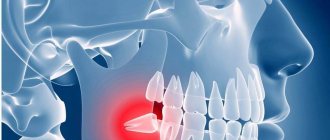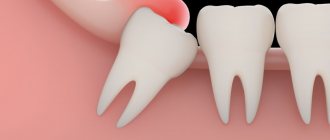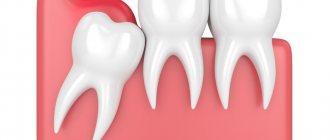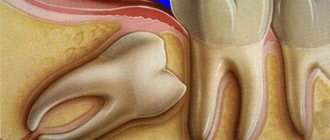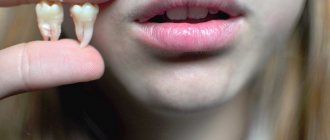A wisdom tooth is the third molar, which appears later than the others, and sometimes does not erupt at all. A person cannot have more than 4 wisdom teeth. The approximate time when teething begins is 18 - 27 years.
Modern experts classify wisdom teeth as rudiments - elements that, in the course of evolution, have lost their role for humans. The specific location of third molars causes a number of difficulties in terms of caring for them.
“Eights” are not loaded like other teeth. In addition, they almost always tend to erupt painfully. It is not surprising that they are called the most problematic, and most dentists recommend removing wisdom teeth at the first opportunity.
Why does wisdom tooth hurt?
Wisdom teeth almost always grow crooked. Problems with teething are dictated by the following anatomical features:
- “Eights” appear later than all other teeth. As a rule, the jaw bones are fully formed, the dentition is stable, and the “newbie” simply does not have enough space;
- The third molars do not have milk “predecessors”, and the rudiments of wisdom teeth developed for too long and not in very favorable conditions. Because of this, they erupt chaotically, damaging the adjacent tooth or causing inflammation of the gums.
When talking about the causes of pain associated with one or more molars, it is worth distinguishing between some concepts. Toothache can occur against the background of abnormal eruption, due to deformations of soft tissues of neighboring teeth. This clinical picture is typical only for “eights”; other teeth are cut much more smoothly.
Causes
However, the cause of toothache may also lie in fairly classic causes associated with common dental pathologies: caries, periodontal disease or periodontitis. If you systematize all the reasons that cause tooth pain, you will get the following list:
- The wisdom tooth rests too much on the tissues of the oral cavity, squeezing and injuring them;
- The tooth is rotated around its axis. The greater the angle of rotation, the more tense the dental nerve is, which provokes pain;
- Carious cavities have formed on the surface of the wisdom teeth; if they reach the dental tissues, the pain will intensify;
- Tartar deposits have formed, which rub the gums and cause inflammation;
- Due to the fact that the rapid growth of the “eight” and crooked eruption damaged the root system of the neighboring molar, it is this neighboring tooth that hurts;
- If the wisdom tooth, due to its incorrect position, begins to pinch the jaw nerve, pain occurs in the lower jaw. In this case, neuritis manifests itself in this way;
- A follicular cyst has formed at the neck of the tooth. It often occurs against the background of permanent damage to the gum tissue and the tooth itself.
It is worth noting the fact that a follicular cyst near wisdom teeth is often accompanied by all sorts of complications. For example, an abscess may occur that can even deform the jaw in a neglected state. The periodontal tissues may also become inflamed and pericoronitis may develop.
Inflammatory processes of the tissue covering the wisdom tooth
Inflammation of the hood is a common phenomenon. If a wisdom tooth erupts through several crown cusps at once, phenomena may occur when the chewing surface of the crown is partially covered by tissue. The part of the gum and mucous membrane that overhangs the molar and is called the hood. He is constantly susceptible to injury and prone to inflammation.
Under the surface of the hood, particularly favorable conditions arise for the accumulation of various biological “garbage” and the proliferation of pathogenic bacteria. Often even the slightest damage causes irritation. The gums around the “eight” may not hurt much, so they don’t always turn to people with such a problem.
However, if the inflammatory process is severe, the tissues not only swell, but are also irritated. The patient complains of painful swallowing, sometimes it is difficult even to simply open his mouth. There may be pus and severe hyperemia on the gum near the wisdom tooth. Only a doctor can save you from such an obsessive and severe dental inflammation by excision of the hood.
Lack of space during teething
If there is not enough space for the wisdom tooth in the dentition, neighboring tissues are injured during eruption. The pain is total. It hurts not only the place where the molar erupts, but also the neighboring teeth. Swelling, hyperemia, and severe pain that are permanent may also be observed. It is difficult for the patient to open his mouth, especially if the “eights” grow in the direction opposite to the jaw. Such teeth must be removed. This is due to the fact that a crooked tooth can damage the entire dentition, up to its noticeable curvature.
Caries
If a wisdom tooth is affected by caries, the first symptom indicating the disease will be pathological increased sensitivity of the teeth. They will react painfully to any irritants - sour, spicy, salty foods, sweets, cold irritants.
Situations often occur when the curvature of a wisdom tooth injures the neighboring tooth, which causes caries in it. The most dangerous situation is when the “eight” damages the root of the neighboring “seven”. Caries develops just below the gum, and the doctor is not always able to visually identify the carious lesion. At the same time, a severely advanced form of “root” caries is difficult to treat and the tooth can almost never be saved.
Pulpitis
In acute pulpitis that affects the wisdom tooth, patients complain of acute pain that occurs in attacks. The disease and its main manifestations are characterized by a spontaneous nature. Unpleasant sensations can occur spontaneously and last up to 15 - 30 minutes. At night the pain intensifies.
In the chronic form of wisdom tooth pulpitis, the pain is not so pronounced. Unpleasant, aching sensations occur against the background of exposure to cold or heat. If the irritant is removed, the pain continues for some time.
Periodontitis
Periodontitis is characterized by aching pain that constantly worries the patient. At the same time, the diseased tooth will react to any irritant with acute pulsating, shooting pain. Slight mobility of the affected tooth is also noted, and swelling and soreness of the gums are often observed.
It is interesting that with chronic periodontitis the pain is almost not disturbing. Very minor unpleasant sensations can only appear when the “figure eight” is tapped on the patient’s tissues.
Gingivitis and lymph nodes
Gingivitis is an inflammatory disease of the gums that occurs due to the formation of plaque on the teeth and the spread of microbes. It often develops in people who do not take good care of their oral hygiene. Typical symptoms of gingivitis are itching and bleeding of the gums, swelling, and pain, especially when soft tissue comes into contact with hard objects, such as a toothbrush.
This pathology can occur in various forms. If the lymph node is inflamed, it may be ulcerative-necrotizing gingivitis. Its other signs are:
- strong pain;
- copious amounts of saliva;
- formation of ulcers;
- increased body temperature;
- loss of appetite;
- headache.
One of the complications of gingivitis if left untreated is periodontitis.
Diagnostics
Any pathology associated with the problematic eruption of one or more wisdom teeth should always be investigated through x-ray diagnostics. To determine the position of the tooth in the jaw (inclination, shape, configuration, structure, how it grows), an orthopantomogram is used.
OPTG is a high-quality panoramic image of all teeth on both jaws. Another diagnostic method that will help you understand why your wisdom tooth hurts is visiography.
Pulpitis and inflammation of the lymph nodes
Pulpitis is an inflammation of the pulp - the nerve tissue inside the tooth. It often occurs in people with advanced caries at a deep stage. The following symptoms are characteristic of pulpitis:
- Acute pain that occurs both at rest and when the tooth is exposed to various irritants: food, brushes, water, etc. After eliminating the factor that provoked the pain, the symptom persists for some time, but gradually subsides. The pain is usually sharp and intense; it cannot be eliminated with analgesics.
- Headaches, pain in the ear area from the affected tooth, general malaise and increased fatigue. The pain may radiate to the temple and eyebrow.
- Increase in local and general temperature. In adults it can rise to 38°C, and in children even higher.
- Swelling of the submandibular lymph nodes, pain when swallowing and chewing food.
With pulpitis, as a rule, it is necessary to remove the diseased nerve, after which the tooth becomes dead and noticeably darkens.
Treatment methods
Experts practice removal of wisdom teeth in case of carious lesions or in cases where extremely problematic eruption is observed for people of any age. Pain and inflammation indicate a serious problem. If it is not resolved in a timely manner, complications cannot be avoided.
Easy removal
The doctor decides what to do in each specific situation based on the research results obtained. This can be either a simple removal or a rather complex multi-stage operation.
Before the procedure, the specialist must make sure that the patient is not allergic to the medications that will be used during the procedures. First, the soft tissue around the tooth and the nerves are numbed. After the anesthesia has taken effect, the tooth is removed using forceps. The duration of the entire procedure does not exceed 10 minutes.
Difficult removal
If the crown of a tooth is destroyed, it has large branched roots, and also if the “eight” has not erupted at all, and the entire jaw is involved in the inflammatory process, complex removal is practiced. During the intervention, the dental surgeon makes one or more incisions, removes the tooth, washes the wound surface, and then applies sutures.
It is also worth mentioning the procedure for excision of the hood. If it is the wisdom tooth that hurts at the time of eruption due to inflammatory processes of the mucous membrane, the doctor removes fragments of “excess” tissue. There may be situations when the wisdom tooth is not removed, but only soft tissue correction is performed. This is true if the tooth itself does not hurt and is located correctly in the socket.
Disease prevention
The risk of inflammation is reduced with timely treatment of infectious and inflammatory processes in the oral cavity. It is important to monitor the quality of personal hygiene so that plaque does not linger in the mouth, tartar or caries does not form.
Prevention at home includes:
- brush your teeth at least 2 times a day with an individually selected brush;
- use mouthwash after brushing (against caries);
- drink purified drinking water;
- change the brush every 3 months or when the bristles wear out;
- limit your consumption of sweets.
☝️ Set a reminder to visit the dentist at least once every 6 months. Make an appointment with your doctor for an examination and photographs of your oral cavity to prevent the development of caries. Visit a hygienist for a comprehensive dental cleaning.
What are the symptoms of inflammation of the lymph nodes?
The submandibular lymph nodes become inflamed against the background of other pathologies, each of which has its own specific symptoms. We list the most common signs of lymphadenitis:
- sudden enlargement of the lymph nodes under the lower jaw, their pain when pressed and hardening;
- first slight and then severe redness of the inflamed areas, they become burgundy and sometimes bluish;
- swelling at the site of inflammation on one or both sides, depending on the etiology of lymphadenitis;
- sharp and short-term attacks of pain that radiate to the ear, temple or eyebrow;
- discomfort when chewing food, increased pain during swallowing;
- inflammation of the oral mucosa, which is accompanied by redness and increased sensitivity;
- increased body temperature, general weakness, sleep disturbance, fatigue.
To make a diagnosis, it is important to determine not only the cause, but also the type of lymphadenitis, since the clinical picture of each of them may be different.

